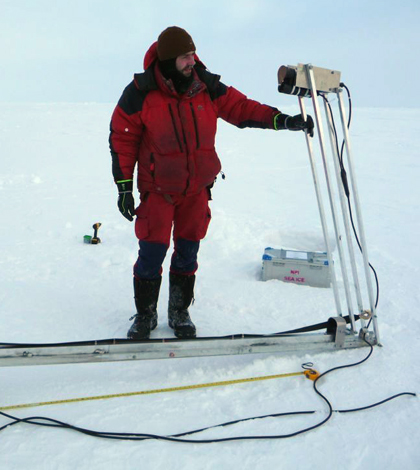Buoy delivers rare real-time albedo data from Arctic ice floe

A buoy deployed on an ice floe near the North Pole has given an international collaboration of scientists new and more reliable data on role of snow and sunlight in the melting of Arctic ice.
The Spectral Radiation Buoy drifted southward from the pole in the summers of 2012 and 2013, autonomously collecting rare reliable data on the ice’s albedo and other properties. The buoy was developed through the AMORA, or Advancing Modeling and Observation solar Radiation of Arctic Sea ice, project, a collaboration between scientists from Norway, China, Germany, Finland and the United States.
“Ice has a lot of implications for a variety of issues, like climate,” said Sebastian Gerland, a research scientist with the Norwegian Polar Institute. “The ice reflects solar radiation and protects the ocean’s ecosystems and animals,” adding that ice can also affect human activities such as travelling, industry and tourism.
Sea ice albedo has traditionally been measured during long expeditions to remote areas. “The data could not be transmitted, it had to be written,” Gerland said. However, the Spectral Radiation Buoy made regular data transmission possible, with solar radiation data transmitted every half hour.
The buoy was built by the Institute’s scientists and engineers with off-the-shelf optical sensors. The buoy was built to be “robust, to withstand the conditions over time,” Gerland said. The buoy completed its first voyage without incident. However, it broke an arm during its second trip.
The buoy was originally launched in summer 2012 and then again the following summer. It traveled from its launch point at the North Pole to the Fram Strait, in the middle of Svalbard and Greenland.

The Spectral Radiation Buoy pioneered the autonomous collection of real-time albedo data on Arctic ice flow. (Credit: Norwegian Polar Institute)
Gerland said there were significant differences between their observations of 2012 and 2013. Summer of 2012 had the lowest level of Arctic sea ice on record; the following summer’s ice levels were closer to normal.
The buoy’s information about the sea ice’s albedo also helped the scientists to process how snow cover affects the melting arctic ice. Puddles that form on top of the snow reduce the ice’s albedo and speeds melting.
“A number of factors determined how much melting takes place — the presence of snow, thickness of ice, water temperature and rate of radiation above and below ice,” Gerland said. Thanks to the AMORA project, “We can see in detail how the melting season develops and we can give specific times for the changes,” he said.
Gerland said albedo plays an integral role in creating dependable climate models. Albedo is an expression of how much solar radiation is reflected by the surface that must be measured accurately for calculating melting. “If you get it wrong, then you won’t know know at what rate the ice is melting,” he said.
A key part of the project was the collaboration between Norwegian and Chinese researchers from the Polar Research Institute of China Shanghai and the Dalian University of Technology. “It was very inspiring to work with scientists from other countries and to see all that enthusiasm,” Gerland said.
AMORA was considered a success, according to Gerland. “We worked together as a team; we got good data,” he said, “It was a very satisfying endeavor.”
Top image: Engineers designed the Spectral Radiation Buoy to withstand harsh conditions throughout its deployment. (Credit: Norwegian Polar Institute)




0 comments